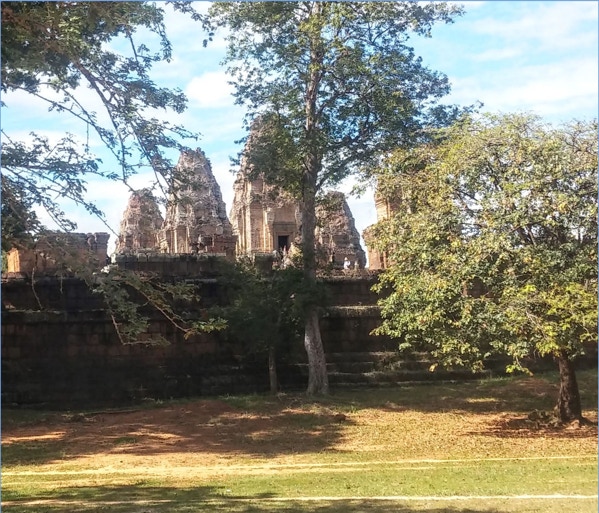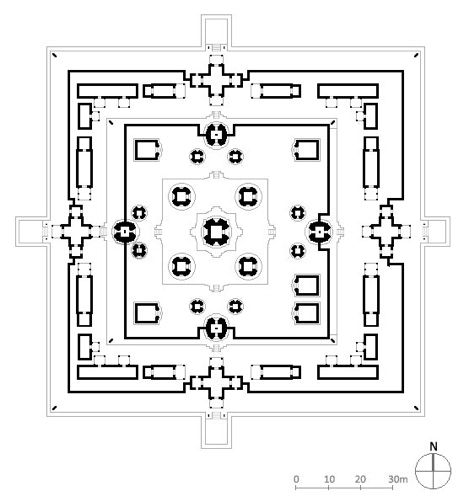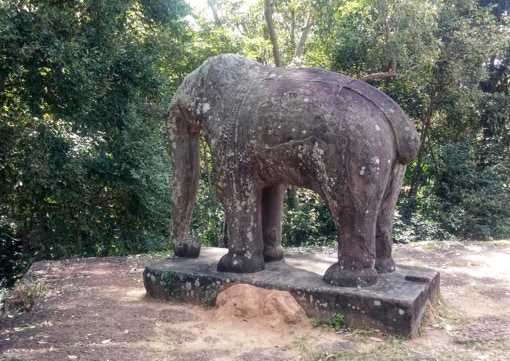EAST MEBON
(953)

EAST MEBON
(953)

THE TEMPLE FROM THE FLOOR OF THE EAST BARAY, EAST MEBON (953)
Upon assuming power in 944 and returning the Khmer capital to Angkor, Rajendravarman's first building project underlined his ties with his predecessors prior to the twenty-four year interregnum at Koh Ker following Jayavarman IV's usurpation of the throne. He built an ancestor temple in the tradition of Preah Ko and Lolei and even placed it on an island in the center of his predecessor, Yashovarman I's (889-915,) East Baray; this tradition was continued by Udayadityavarman I's West Mebon (TPQ 1050) and Jayavarman VII's Neak Pean (1181-1220.) East Mebon's architect, Kavindarimimathana, (the only Khmer shthapaka whose name we know,) was also responsible for building Pre Rup (961,) Rajendravarman's own state temple mountain and another sign of continuity with the past.
From this photograph's perspective the quincunx or panchayatana of five towers appears to occupy the upper terrace of a temple pyramid, an illusion resulting from its being taken from what was the floor of the baray but today is dry and used for rice cultivation. The wall in the foreground was, in fact, the underwater retaining wall for the temple island. The indentation at right is a recess in the outer or 2nd enclosure wall to make room for a landing stage since the only way to approach the temple was originally by water.

SITE PLAN, EAST MEBON (953)
This outer enclosure is almost entirely lined with the narrow rectangular structures, also found at the Bakong (881), Prasat Thom (928-944) and Pre Rup (961,) usually referred to as "service buildings" in the absence of any evidence of their actual function. The 1st enclosure or upper terrace is not much higher than the 2nd and its five shrines sit flat upon a low plinth; its wall and gopuras, recessed on the east, contain eight, small, brick shrines symmetrically arrayed, (in contrast with the Bakong’s,) around the quincunx. In addition, there are three, square, west-facing and two, east-facing corner shrines which do not seem to have been "libraries" since they do not flank the east-west axis and since there is no precedent for east-facing libraries. They more resemble the "crematoria" at the Bakong, Phnom Krom and Phnom Bok; these would, however, seem supererogatory at a temple, dedicated to Rajendravarman's long-dead parents, suggesting they may have served instead as intercardinal "guardian shrines" along with the eight small shrine flanking the gopura in the cardinal directions.
The upper terrace holds the quincunx or panchayatana of five shrines, as at Phnom Bakheng (907); on the west, the plinth is flush with the two rear, east-facing corner shrines, while the two small shrines flanking the 1st west gopura are squeezed close to it and the western enclosure wall; similarly, the 1st and 2nd west gopuras are almost joined as one. The 6.6% westward off-set of the plinth within the temple's overall length, characteristic of all Khmer temples, might be attributed to the desire to maintain an equal width between the plinth, the 1st east gopura and the 2nd, as would exist if the 1st had not been indented on the east in compensation for the landing stage.

INDRA, EAST LINTEL, CENTRAL PRASAT, EAST MEBON (953)
The carving at East Mebon is often counted among the high points of Khmer sculpture. The lintels of the central tower depict the gods associated with the four cardinal directions on their vahanas, their ”mounts" or "vehicles;" on the east, Indra, king of the gods, on his three-headed elephant, Airavata; on the west Varuna, lord of the seas, on a hamsa or goose; on the south, Yama, judge of the dead, on a bullock; and, on the north, Kubera, god of wealth, on his magic chariot, the pushpaka, an example of a "flying palace." (A description of all the directional guardians or dikpalas can be found in appendix V.) On this east lintel (above,) a kala spews a straight garland, (no longer bent as at Prasat Bei and Prasat Kraven,) with two outward-facing makaras or sea monsters with floral scrolls spilling from their mouths. The pendants between the swags add a deliberately antiquating touch, derived as they are from the style of Sambor Prei Kuk. Small devas or gods disport themselves among the foliage while a frieze of rishis, sages or hermits, in niches provides an upper border for the lintel.

YAMA, SOUTH LINTEL, CENTRAL PRASAT, EAST MEBON (953)
On the south lintel (above,) Yama, Lord of the South, the direction of death, and King of the Underworld, rides his “vehicle,” the bullock, wielding a noose with which he catches the spirits of those about to die. He will be pictured similarly in the gruesome south gallery of Angkor Wat which depicts in Dantesque detail the torments of the thirteen narakas or hells. He rides between two makaras, or sea monsters, who spew the garland rather than the more usual kala. Apsaras raise their arms in praise along the garland while warriors strike threatening poses on its outward-facing volutes. Above a row of rishi or hermits each prays in his shrine or cave. As with the three other lintels of the Central Prasat the carving shows a confident command of the chisel through its deep, crisp, constant curves.
This elephant on the southeast corner of the first (lower or outer) terrace is one of eight at the corners of East Mebon's two terraces. Symbols of strength, they function as guardians of the intercardinal directions and establish a further link to the Khmer architectural past, specifically the elephants originally on the corners of the three lower terraces of the Bakong.

SOUTHEAST CORNER, 1ST TERRACE, EAST MEBON (953)
50